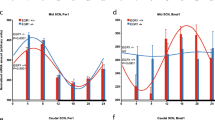Abstract
We examined the role of c-fos in the synchronization of circadian rhythms to environmental light cycles using a line of gene-targeted mice carrying a null mutation at this locus. Circadian locomotor rhythms in mutants had similar periods as wild-type controls but took significantly longer than controls to entrain to 12:12 light-dark cycles. Light-induced phase shifts of rhythms in constant dark were attenuated in mutants although the circadian timing of phase delays and advances was not changed. A functional retinohypothalamic projection was indicated from behavioral results and light-induced jun-B expression in the SCN. The results indicate that while c-fos activation is not an absolute requirement for rhythm generation nor photic responses, it is required for normal entrainment of the mammalian biological clock.
Similar content being viewed by others
Abbreviations
- SCN :
-
suprachiasmatic nucleus
- RHT :
-
retinohypothalamic tract
- IEG :
-
immediate early genes
- NGF :
-
nerve growth factor
- VIP :
-
vasoactive intestinal polypeptide
- DD :
-
constant darkness
- CT :
-
circadian time
References
Angel P, Karin M (1991) The role of Jun, Fos and the AP-1 complex in cell proliferation and transformation. Biochem Biophys Acta 1072: 129–157
Aronin N, Sagar SM, Sharp RR, Schwartz WJ (1990) Light regulates expression of a Fos related protein in rat suprachiasmatic nuclei. Proc Natl Acad Sci USA 87: 5959–5962
Chambille I, Doyle S, Serviere J (1993) Photic induction and circadian expression of Fos-like protein. Immunohistochemical study in the retina and suprachiasmatic nuclei of hamster. Brain Res 612: 138–150
Colwell CS, Foster RG (1992) Photic regulation of Fos-like immunoreactivity in the suprachiasmatic nucleus of the mouse. J Comp Neurol 324: 135–142
Curran T, Sonnenberg JL, Macgregor P, Morgan JI (1990) Transcription factors in the brain: Fos, Jun, and the AP-1 binding sites. In Guiddotti A (ed) Neurotoxicity of excitatory amino acids. Raven Press Ltd, New York, pp 175–184
DeCoursey PJ (1964) Function of a light response in hamsters. J Cell Comp Physiol 3: 189–196
Earnest DJ, Iadarola M, Yeh HH, Olschowka JA (1990) Photic regulation of c-fos expression in neural components governing the entrainment of circadian rhythms. Brain Res 422: 398–402
Earnest DJ, Ouyang S, Olschowka JA (1992) Rhythmic expression of Fos-related proteins within the rat suprachiasmatic nucleus during constant retinal illumination. Neurosci Lett 140: 19–24
Johnson RS, Spiegelman BM, Papaioannou V (1992) Pleiotropic effects of a null mutation in the c-fos proto-oncogene. Cell 71: 577–586
Kerppola TK, Curran T (1994) Maf and Nrl can bind to AP-1 sites and form heterodimers with Fos and Jun. Oncogene 9: 675–684
Klein DC, Moore RY, Reppert SM (eds) (1991) Suprachiasmatic nucleus: The mind's clock. Oxford University Press, Oxford
Kornhauser JM, Nelson DE, Mayo KE, Takahashi JS (1990) Photic and circadian regulation of c-fos gene expression in the hamster suprachiasmatic nucleus. Neuron 5: 127–134
Kornhauser JM, Nelson DE, Mayo KE, Takahashi JS (1992a) Regulation of jun-B messenger and AP-1 activity by light and a circadian clock. Science 255: 1581–1584
Kornhauser JM, Mayo KE, Takahashi JS (1992b) Immediate-early gene expression in a mammalian circadian pacemaker: the suprachiasmatic nucleus. In: Young MW (ed). Molecular genetics of circadian rhythms. Marcel Dekker, New York, pp 271–307
Morgan JI, Curran T (1989) Stimulus-transcription coupling in neurons: role of cellular immediate-early genes. Trends Neurosci 12: 459–462
Morgan JI, Curran T (1990) Stimulus-transcription coupling in the nervous system: involvement of the inducible proto-oncogenes fos and jun. Annu Rev Neurosci 142: 421–451
Morin LP (1994) The circadian visual system. Brain Res Rev 67: 102–127
Nelson DE, Takahashi JS (1991) Sensitivity and integration in a visual pathway for circadian entrainment in the hamster (Mesocricetus auratus). J Physiol (Lond) 439: 115–145
Paylor R, Johnson RS, Papaioannou V, Spiegelman BM, Wehner JM (1994) Behavioral assessment of c-fos mutant mice. Brain Res 651: 275–282
Pittendrigh CS (1960) Circadian rhythms and the organization of living systems. Cold Spring Harbor Symp Quant Biol 25: 159–182
Pittendrigh CS, Daan S (1976) A functional analysis of circadian pacemakers in nocturnal rodents I. Stability and lability of spontaneous frequency. J Comp Physiol 106: 223–253
Rea M (1989) Light increases Fos-related protein immunoreactivity in the rat suprachiasmatic nuclei. Brain Res Bull 23: 577–581
Rusak B, Robertson HA, Wisden W, Hunt SP (1990) Light pulses that shift rhythms induce gene expression in the suprachiasmatic nucleus. Science 248: 1237–1240.
Schwartz WJ, Zimmerman P (1990) Circadian timekeeping in BALB/c and C57BL/6 inbred mouse strains. J Neurosci 10: 3685–3694
Takeuchi J, Shannon W, Aronin N, Schwartz WJ (1993) Compositional changes of AP-1 DNA-binding proteins are regulated by light in a mammalian circadian clock. Neuron 11: 825–836
Vitaterna MH, Wu JC, Turek FW, Pinto LH (1993) Reduced light sensitivity of the circadian clock in the hypopigmented mouse mutant. Exp Brain Res 95: 436–442
Author information
Authors and Affiliations
Rights and permissions
About this article
Cite this article
Honrado, G.I., Johnson, R.S., Golombek, D.A. et al. The circadian system of c-fos deficient mice. J Comp Physiol A 178, 563–570 (1996). https://doi.org/10.1007/BF00190186
Accepted:
Issue Date:
DOI: https://doi.org/10.1007/BF00190186




